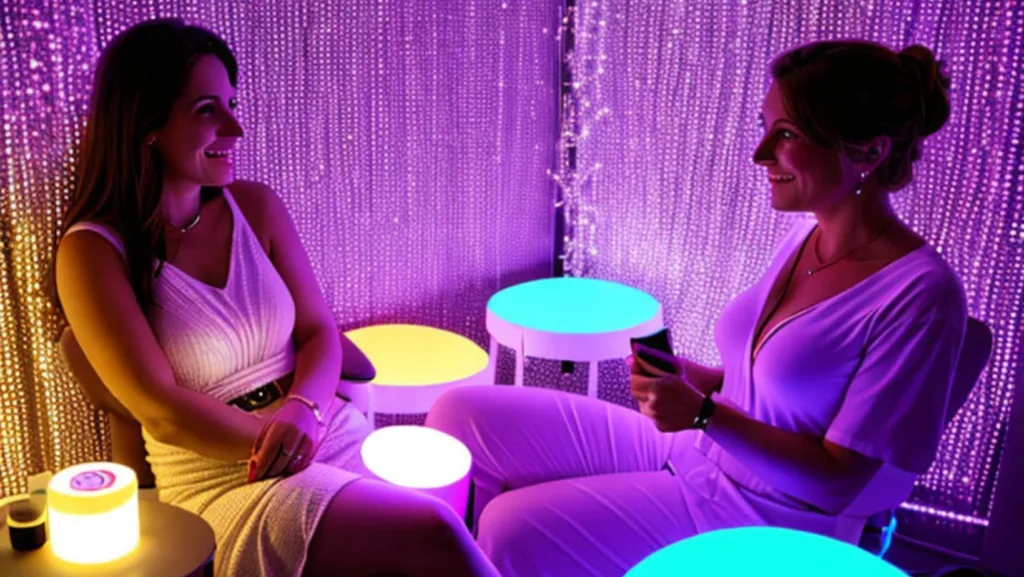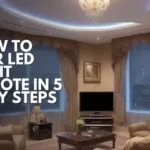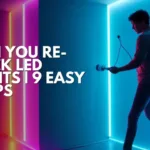Are you tired of the same old LED light colors? Want to add a dash of excitement to your space with some hot pink vibes? Look no further! In this simple guide, we’ll show you how to make hot pink on led lights that’ll make your room look like an utopia.
How to make Hot Pink on LED lights Step-by-Step Guide

I have tried a lot of color combinations on LED lights and my personal favorite is Cyan as it creates relaxing ambiance but don’t worry I will teach you how to make hot pink on led lights and make your Space look like a piece of paradise:
Step 1: Gather Your Supplies
Before you can dive into creating hot pink LED lights, you’ll need a few things:
LED Light Strips: These can be found at most hardware or electronics stores. Ensure they are capable of displaying a variety of colors.
Remote Control: The remote control that comes with your LED lights is your magic wand for changing colors.
Power Source: Make sure your LED lights are properly connected to a power source.
Sense of Humor: A pinch of humor can make the process more enjoyable. After all, we’re here to have fun while we DIY, right?
Step 2: Turn on the Lights
Switch on your LED lights using the remote control. If you’ve never used it before, it’s okay to giggle a little as you navigate through the options. LED lights can display a rainbow of colors, but we’re on a mission to find hot pink!
Step 3: Access the Color Settings
Most LED light remotes have a color wheel or a set of color buttons. Locate the one that allows you to select a specific color. It might be labeled “Color,” “Hue,” or “RGB.”
Step 4: Customize Your Color
Now comes the fun part. To make hot pink, you’ll want to adjust the color settings. Hot pink is a vivid shade of pink with a hint of purple. To achieve this, play around with the color controls. Increase the red and blue while decreasing the green. You can think of it as mixing paint colors, but with light!
Step 5: Fine-Tune the Shade
You might need to experiment a bit to get the exact shade of hot pink you desire. Tweak the color settings until it looks just right. Don’t worry; there’s no such thing as too much pink!
Once you’ve found that perfect hot pink hue, bask in the vibrant glow of your LED lights. Whether you’re creating a romantic atmosphere for a date night or throwing a neon-themed party, your hot pink LED lights are sure to impress. By following above steps of how to make hot pink on led lights you will achieve that romantic ambiance. ENJOY!
How to Create Custom Colors on LED Lights: A Fun and Illuminating Guide

If you’re bored of hot pink LED color here is quick 8 steps to have create your Custom Colors on LED Lights:
Materials You’ll Need
- LED light strips or bulbs
- LED controller or remote
- Smartphone or computer with RGB color wheel
- A dash of creativity
Step 1: Get Your LED Setup Ready
Before you can start creating custom colors, you need the right tools. Make sure you have LED lights and a controller or remote that allows you to adjust the colors. LED strips are versatile and can be easily mounted under shelves, on walls, or wherever you want to add a splash of color.
Step 2: Understand the RGB Color Wheel
RGB stands for Red, Green, and Blue, the primary colors used in LED lighting. To create custom colors, you’ll need to mix these three colors in different proportions. Think of it as a delicious recipe where you’re the chef, and colors are your ingredients.
Step 3: Experiment with Color Mixing
Now, let’s have some fun! Use your LED controller or remote to adjust the intensity of the Red, Green, and Blue LEDs. Play around with the sliders until you find the color you like. Want a soft lavender? Mix some blue and a hint of red. How about a vibrant turquoise? Boost the green and blue.
Step 4: Save Your Creations
Once you’ve created a custom color that’s Instagram-worthy, save it! Most LED controllers allow you to store your favorite colors for easy access. Give them quirky names like “Tropical Teal” or “Midnight Magenta” to impress your friends.
Step 5: Sync with Your Smartphone or Computer
Many modern LED setups come with smartphone apps or computer software that sync with your lights. This means you can create custom colors on a digital color wheel with even more precision. It’s like having a virtual paint palette for your room!
Step 6: Set the Mood
Now that you’ve mastered the art of custom colors, it’s time to set the mood. Use your newfound expertise to create the perfect ambiance for any occasion. Hosting a romantic dinner? Go for warm, soft tones. Throwing a wild party? Crank up the intensity with bold and vibrant colors.
Step 7: Show Off Your Skills
Invite your friends over and watch their jaws drop as they witness your LED lighting masterpiece. Impress them with your custom color creations and maybe even challenge them to a color-mixing contest.
Step 8: Don’t Be Afraid to Evolve
As your creativity evolves, so can your custom color schemes. Don’t hesitate to experiment with different color combinations and effects. After all, the beauty of LED lights is that they can adapt to your ever-changing style.
A Comprehensive Guide to RGB LED Color Combinations

I want you not to Struggle with LED colors so here is quick Comprehensive Guide to RGB LED Color Combinations follow the blog to become a pro LED light combination expert:
Understanding RGB: The Primary Trio
RGB is a color model that uses combinations of red, green, and blue light to create various colors. Think of them as the primary colors of the digital universe. Just as mixing paint yields different colors on a canvas, blending varying intensities of red, green, and blue light produces a broad spectrum of colors in the world of LEDs.
The Art of Mixing Light
Imagine you have a bucket of red, green, and blue paints, and you want to create a specific color. To achieve that, you’d mix the primary colors in different proportions. The same principle applies to RGB LEDs. By adjusting the brightness of each diode, you can craft a virtually endless palette of colors.
Here’s where it gets interesting – by using just the three primary colors, you can produce over 16 million different hues! It’s like having a paintbox with limitless possibilities. Whether you’re designing eye-catching lighting displays or customizing your gaming rig, understanding RGB color combinations is your ticket to a world of creative expression.
Mixing the Magic: Creating RGB LED Colors
Red + Green = Yellow: When you shine red and green at full blast, you get a sunny yellow. Great for creating warm, cheerful atmospheres in your living room or adding a pop of color to your digital artwork.
Red + Blue = Magenta: Combining red and blue LEDs results in a vibrant magenta. Perfect for adding a touch of mystery to your party decor or creating eye-catching signage.
Green + Blue = Cyan: Mixing green and blue gives you a refreshing cyan. Ideal for creating an aquatic ambiance in your home aquarium or adding a futuristic vibe to your workspace.
Red + Green + Blue = White: Now, if you turn all three LEDs to full brightness, you’ll get pure white light. This is your go-to for clean and crisp illumination, perfect for reading, task lighting, or setting the mood for a romantic dinner.
Play with Intensity: Remember, the magic lies in adjusting the intensity of each color. Dimming one and enhancing another allows you to create subtle gradients, pastel shades, and everything in between.
The RGB LED Color Wheel
Just like an artist’s color wheel, you can visualize RGB colors as a circle. Starting with red at the top, moving clockwise, you’ll encounter all the colors we mentioned earlier. As you blend different amounts of red, green, and blue, you navigate this color wheel to create your desired shade.
Expert Tips for RGB Mastery
Don’t Overdo It: While it’s tempting to bathe your room in a disco of colors, remember that less is often more. Subtle shifts in color can have a big impact.
Test, Test, Test: Play around with different combinations to find what works best for your space or project. You’re not just an enthusiast; you’re a lighting maestro!
Sync It Up: Many RGB LED systems come with software or controllers that let you sync your lights with music, games, or even your mood. Take advantage of these features to create truly immersive experiences.
Read More: 17 Best ways to achieve baddie aesthetic room with led lights
Read More: 10 Reasons Why Your LED Lights Suddenly Stop Working | Solutions
Conclusion:
Making hot pink on LED lights is a breeze. With a bit of humor, experimentation, and the right remote control, you’ll have your room glowing with fabulousness in no time. So go ahead, embrace your inner Pink Panther, and let your LED lights shine!
I hope this blog on how to make hot pink on led lights have help you achieve vibrant glow to your space. Type “YES” in the comment section if it did!
FAQ- Custom Colors on LED Lights
How to Make Pink on LED Lights With Remote?
To make pink on LED lights with a remote, mix red and blue colors.
Is it good to sleep with pink LED lights?
Pink LED lights can be suitable for sleep, as they promote a calming atmosphere.
Do pink LED Lights attract bugs?
Pink LED lights typically attract fewer bugs than other colors.
What two primary colors make hot pink?
Hot pink is made by mixing red and magenta LED lights.
How to make peach on led lights?
To create peach on LED lights, blend orange and pink colors.
How to make dark purple on led lights?
To achieve dark purple on LED lights, combine blue and magenta hues.
How to make purple led lights?
For purple LED lights, mix red and blue in varying intensities.











1 thought on “How to make Hot Pink on LED lights in 5 Easy Steps”